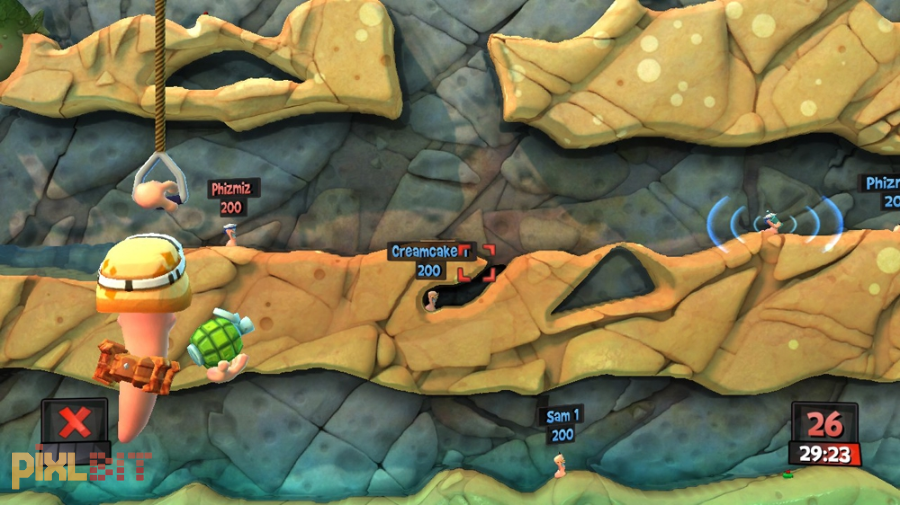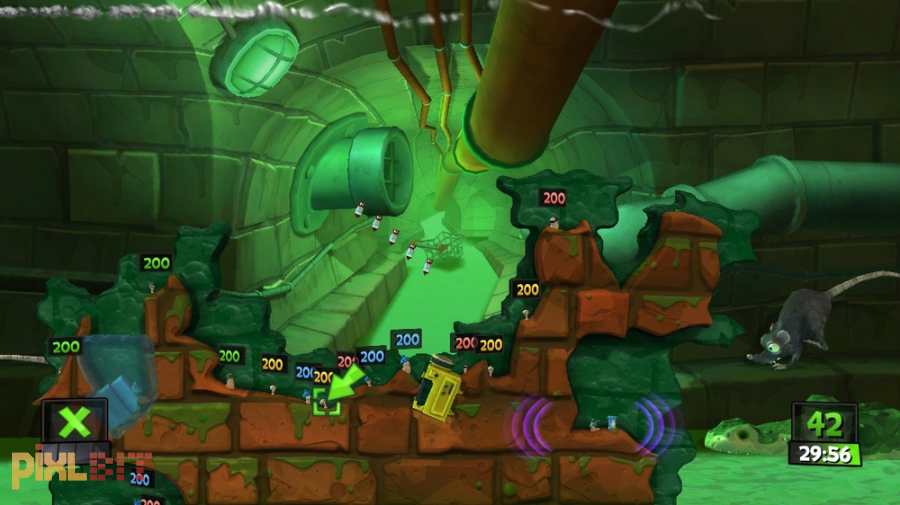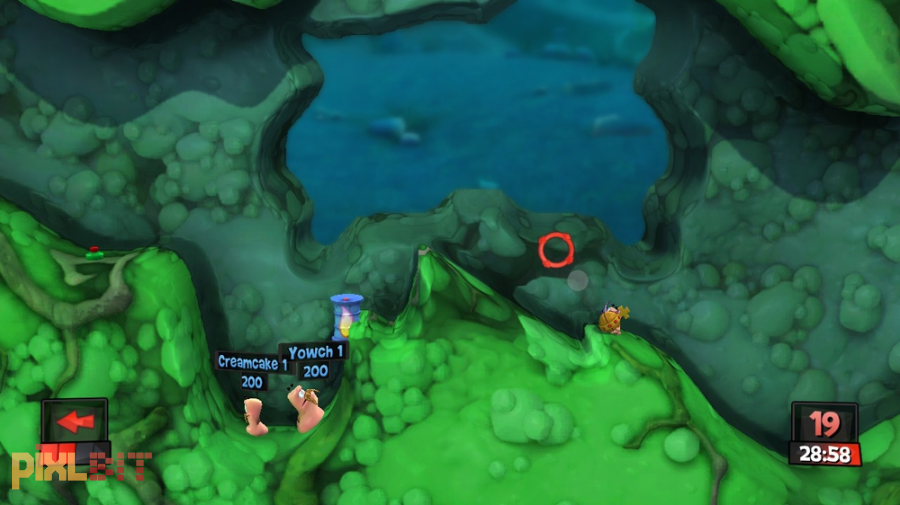God I love Holy Hand Grenades. ^^
Worms: Revolution Review
|
|
See PixlBit's Review Policies

On 11/03/2012 at 12:00 PM by Julian Titus Just add water. And worms. |

Some interesting additions to the formula will amuse Worms fans, but this game won't win over any holdouts.
My introduction to Worms came with Worms Armageddon for the Nintendo 64. I was working in gaming retail at the time, and that game took our store by storm. We’d spend hours after closing playing that game, and those are some of my most cherished multiplayer memories. Since then, I’ve been chasing that feeling, only to come up short every time. The first Worms on XBLA felt stripped down, and I couldn’t find anyone to play Worms Armageddon 2 with me. So here I am, playing Worms Revolution for review, and trying desperately to recapture that magic I felt huddled around an N64 with three of my friends. Even though Revolution is an enjoyable game, it seems that my quest continues.
It had been some time since I’d been in control of a squad of wormy footsoldiers, so I jumped into the tutorial and single player campaigns right off the bat for a refresher course and to check out the new game mechanics. Each of the Worms games have tinkered with the formula a bit, and Revolution adds a few major features to varied degrees of success. Matt Berry (of The IT Crowd fame) is your narrator for all single player content, and while I adore that man’s voice he talks way too much, slowing down the single player proceedings. The single player levels somehow hold the player’s hand by giving way too obvious hints at what needs to be done while simultaneously not teaching the finer points of the controls. They do, however, teach you the best ways to get the other team wet.
Water is the focal point for Worms Revolution—the levels are replete with the wet stuff. Now, water has pretty much always been part of the game, but this time around it’s common to find pockets of liquid scattered throughout the randomly generated levels. Unleashing these reservoirs can have the type of unpredictable effects one would expect from the Worms series. Submerged worms don’t die immediately, but take damage for each turn that they remain underwater. The major tactical advantage to the water mechanic comes in the form of sweeping worms away in a torrent—hopefully taking them off the map or pushing them into a mine.
Various water-based weapons allow for aquatic play even when the levels come up a bit dry, and these were some of the most unique and fun additions to the formula for me. The Prod has always been the ultimate insult—poking a worm right off a ledge is classic. However, I found some sick satisfaction in using a water gun to rain on some worm’s parade, hopefully taking a couple of his friends in the process. Water ended up as a fun supplement to my normal tactics, even if the physics and overall look of the liquid don’t resemble H20 in any way, shape or form; instead, it pools together like jelly.
Worms made the jump into the third dimension some time ago, but this time the game sports polygonal graphics in a 2D perspective. I found that this gives the worms even more personality than ever, but the main advantage of the 3D graphics comes in the form of physics. The levels sport all manner of objects that can be manipulated and moved to make traversal easier or really mess up a worm’s day. A new telekinesis weapon is the best way to utilize these objects, but I was disappointed in this addition. It isn't used much, and moving objects never quite gives the result I was hoping for. You could say that’s part of the Worms charm, but I ended up relying on my tried and true bazookas, grenades, and dynamite for most battles.
I’ve never enjoyed playing against the computer in the Worms games. The AI always takes too long to act, and more often than not will perform that perfect grenade lob or arc a bazooka rocket for a nearly impossible shot. As clever as the puzzle missions are, and as interesting as the single player campaign may be, Worms has always been a multiplayer experience for me. So I quickly moved into that part of the game, trying to capture that delirious fun I remembered from the N64 days.
What I found is that, for me, the perfect Worms experience is a group of people in the same room, wreaking wormy havoc on each other in myriads of sinister ways. Playing online just isn’t the same. Beyond normal issues such as difficulty in finding open games (it was quietly released with little fanfare or marketing), playing against random strangers doesn’t hold the same appeal for me. Worms Revolution feels slow at the best of times, and this is exacerbated online, where the game stutters at turn transitions. Ranked matches—which were the only games I could readily find—have a long setup process as each player takes turns placing their worms. I suppose this puts people on a more even playing field, but I would much rather let the chips fall where they may and get to the action right away.
This game features new worm classes beyond the standard worm soldier we all know and love. There’s the slow but powerful Heavy, the weaker Scientist who has a health regen effect for his whole team each turn, and the speedy Scout that jumps twice as high. I didn’t see much use in any of the new classes besides the Scout simply because he made the game feel a little faster. Worms plods at a glacial pace, and without people in the room to trash talk with, the experience left me yawning. I wish my old friends could come over for some old school worm action, but who gets together for couch video gaming anymore?
Worms Revolution adds a couple new things to the classic formula, and for what it is, this is a competent Worms experience. I was chasing a fond gaming memory, but those days are gone. Without those friends to play with, and without crowding onto a couch yelling and laughing when a Holy Hand Grenade throw goes horribly, horribly wrong, it’s just not the same.













Comments